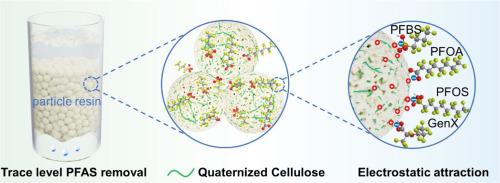Enhanced selective removal of PFAS at trace level using quaternized cellulose-functionalized polymer resin: Performance and mechanism
IF 12.4
1区 环境科学与生态学
Q1 ENGINEERING, ENVIRONMENTAL
引用次数: 0
Abstract
The effective protocol for treating per- and polyfluoroalkyl substances (PFAS) in water at environmentally relevant concentrations (∼ ng L−1) has received unprecedented attention due to the stringent drinking water standards. In order to ensure safe water treatment, sorption using quaternary ammonium functionalized strong-base anion exchange resins (SB-AERs) is considered a viable option for treating PFAS when compared to commercialized activated carbon, as SB-AERs can be in situ regenerated with long-term operation capabilities. However, the harsh conditions required for traditional direct synthesis of SB-AERs (such as prolonged reaction times, complex processes, and environmental pollution caused by the organic reagents used) limit their applications. In this study, we present a novel indirect synthesis method that can effectively pre-functionalizes cellulose for quaternization. This modified cellulose is subsequently loaded onto chloromethylated polystyrene to produce a quaternized cellulose-functionalized polymer resin (QC-CMPS). The process is straightforward to implement, reduces the use of toxic chemicals, and effectively mitigates water safety risks associated with hazardous reagent leaks. As results, the prepared QC-CMPS demonstrates exceptional selective capability for PFAS removal in real environmental water matrices, achieving over 99 % removal efficiency at an initial concentration of 1000 ng L−1. Additionally, QC-CMPS demonstrates low sensitivity to pH and background ions, effectively removing PFAS from both tap water and lake water with efficiency rates exceeding 95 %. The exhausted QC-CMPS can be readily rejuvenated by rinsing with 1 % NaCl and MeOH (V/V=3/7) mixture, as demonstrated by five successful consecutive cycles. The fixed-bed column test confirmed that ∼ 11,000 bed volumes (∼ 292.70 L) of the feed streams (∼250 ng L−1) can be effectively treated with the enrichment factor of 26.42, 25.16, 27.77 and 21.17 for PFOA, PFOS, PFBS, and GenX, respectively, highlighting significant potential for practical applications.

季铵化纤维素功能化聚合物树脂在痕量水平上增强PFAS的选择性去除:性能和机理
由于严格的饮用水标准,以环境相关浓度(~ ng L−1)处理水中全氟烷基和多氟烷基物质(PFAS)的有效方案受到了前所未有的关注。为了确保水处理的安全性,与商业化活性炭相比,使用季铵功能化强碱阴离子交换树脂(SB-AERs)吸附处理PFAS被认为是一种可行的选择,因为SB-AERs可以原位再生并具有长期运行能力。然而,传统的直接合成SB-AERs所需的苛刻条件(如反应时间长、工艺复杂、使用的有机试剂造成的环境污染)限制了它们的应用。在这项研究中,我们提出了一种新的间接合成方法,可以有效地预功能化纤维素进行季铵化。这种改性的纤维素随后被装载到氯甲基化聚苯乙烯上,以生产季铵化纤维素功能化聚合物树脂(QC-CMPS)。该过程易于实施,减少了有毒化学品的使用,并有效降低了与危险试剂泄漏相关的水安全风险。结果表明,制备的QC-CMPS在实际环境水基质中表现出优异的PFAS去除选择性,在初始浓度为1000 ng L−1时,去除率超过99%。此外,QC-CMPS对pH值和背景离子的敏感性较低,可有效去除自来水和湖水中的PFAS,效率超过95%。用1% NaCl和MeOH (V/V=3/7)的混合物漂洗,可以很容易地使耗尽的QC-CMPS恢复活力,这证明了连续五次成功的循环。固定床柱试验证实,对PFOA、PFOS、PFBS和GenX的富集系数分别为26.42、25.16、27.77和21.17,可以有效地处理~ 11000床体积(~ 292.70 L)的进料流(~ 250 ng L−1),突出了实际应用的巨大潜力。
本文章由计算机程序翻译,如有差异,请以英文原文为准。
求助全文
约1分钟内获得全文
求助全文
来源期刊

Water Research
环境科学-工程:环境
CiteScore
20.80
自引率
9.40%
发文量
1307
审稿时长
38 days
期刊介绍:
Water Research, along with its open access companion journal Water Research X, serves as a platform for publishing original research papers covering various aspects of the science and technology related to the anthropogenic water cycle, water quality, and its management worldwide. The audience targeted by the journal comprises biologists, chemical engineers, chemists, civil engineers, environmental engineers, limnologists, and microbiologists. The scope of the journal include:
•Treatment processes for water and wastewaters (municipal, agricultural, industrial, and on-site treatment), including resource recovery and residuals management;
•Urban hydrology including sewer systems, stormwater management, and green infrastructure;
•Drinking water treatment and distribution;
•Potable and non-potable water reuse;
•Sanitation, public health, and risk assessment;
•Anaerobic digestion, solid and hazardous waste management, including source characterization and the effects and control of leachates and gaseous emissions;
•Contaminants (chemical, microbial, anthropogenic particles such as nanoparticles or microplastics) and related water quality sensing, monitoring, fate, and assessment;
•Anthropogenic impacts on inland, tidal, coastal and urban waters, focusing on surface and ground waters, and point and non-point sources of pollution;
•Environmental restoration, linked to surface water, groundwater and groundwater remediation;
•Analysis of the interfaces between sediments and water, and between water and atmosphere, focusing specifically on anthropogenic impacts;
•Mathematical modelling, systems analysis, machine learning, and beneficial use of big data related to the anthropogenic water cycle;
•Socio-economic, policy, and regulations studies.
文献相关原料
公司名称
产品信息
麦克林
Perfluorooctanoic acid (PFOA)
麦克林
Perfluorooctanoic acid
阿拉丁
Perfluoro-2-methyl-3-oxahexanoic acid
阿拉丁
Perfluorobutane sulfonic acid
 求助内容:
求助内容: 应助结果提醒方式:
应助结果提醒方式:


